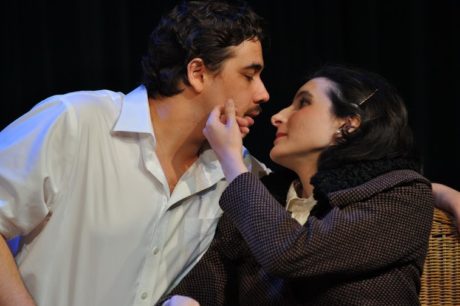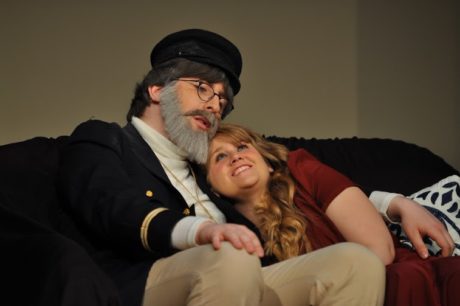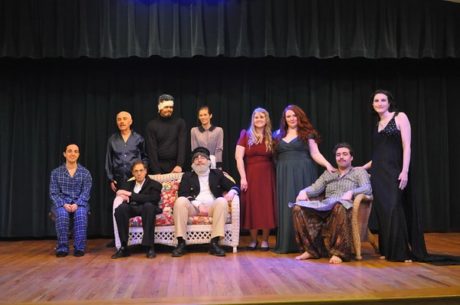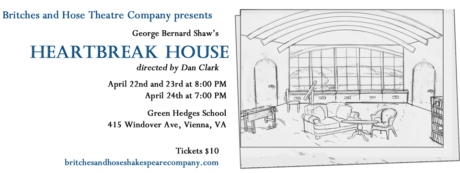Most community theatres would probably not opt to present George Bernard Shaw’s Heartbreak House. It’s a long, thorny play, a derivative of Chekhov’s Cherry Orchard, subtitled A Fantasia in the Russian Manner on English Themes. That sentence alone might give pause. In an ADD and ADHD age where flash fiction reigns and jump cuts are the norm, Shaw is one of those playwrights whom it might be wise to read before seeing. He’s complex, sometimes ludicrous, and always challenging.

Then again, The Britches and Hose Theater Company (B&H) has been producing an eclectic mix of the familiar and the unfamiliar for some time, and the cast is good at it. B&H bills itself as a gender-blind company; men can play women, and women can play men. It goes deeper than that, however, in that B&H makes all roles available to all actors, regardless of age, race, gender, ethnicity, body size or type. They’ve been doing this quite successfully for nearly six years and their credits include Henry IV, A Christmas Carol, Julius Caesar, and The Importance of Being Earnest.
Shaw wrote Heartbreak House in 1913 as World War I loomed, and it was not produced until 1921. The original stage settings called for a room designed to appear like the stern of an old boat. In this case the set is simple and utilitarian—a couch, a wicker armchair, a hutch and a couple of tables. The scarcity of props gives the small stage a largess the actors employ well; the captain’s repeated use of a boatswain’s whistle lets us know we are not in an ordinary room.
Captain Shotover (Gabriel Komisar) is a retired sea captain who lords it over his home as a medieval noble might a duchy. He is cared for by Nurse Guiness (Alex Chappelle), the sole remaining servant of the household, an often frightened woman with a secret. The captain is in pursuit of adversarial ends: serenity, which he calls “the seventh degree of concentration,” and developing the mental skills necessary to explode dynamite from a distance using only his mind. His research into both ambitions calls for heavy drinking.
Shotover’s youngest daughter, Lady Ariadne Utterword (Betsy Ryan) is the wife of Sir Hastings Utterword, a character mentioned often but never seem. Ariadne, who fled her home 23 years earlier to escape her family, returns to England and finds nothing has changed in her father’s house. In fact, the captain does not even recognize her. Captain Shotover’s older daughter, Hesione (Mary Burnett), has invited Ellie Dunn (Mandi Ellis) to the house for dinner. Ellie is a confused young singer, engaged to marry one man but in love with another who, of course, is not who or what he appears to be. In fact, the man Ellie desires madly is a handsome teller of tall tales who just happens to be the Hesione’s husband.
Here the play might devolve into French farce, but thankfully does not. What is at first sight an outrageous situation is made acceptable—and at time outright laughable—by the actors’ skills. It would be tempting to overplay Shaw, to make Heartbreak House a series of large moments backed by large motions. But good theater is often dependent on small movements, and the sympathetic cast knows this. An actor’s pigeon-toed stance can go further than a monologue; a light hand on a shoulder is more evocative than a comedic grimace. Aside from the bombastic Captain Shotover, and the unhappy Boss Mangan, a moneyless financier who ruined Ellie Dunne’s father and yet is destined to marry her, the play is performed with minimal histrionics. This is a wise choice that Director Dan Clark made effective. His actors don’t overreact, they act.
The best lines belong to the women—they get the zingers. The men are largely foils—believable ones but second-class citizens on this stage. Lady Utterword is as shrill as the upper class she represents and unkind to the unfortunate Randall (Marta Soto), her brother-in-law who, armed with a flute, seeks to foil the intentions of other men enamored of her. Randall is played shyly by Marta Soto. His every move is a struggle against hesitancy. Matched against the indomitable Ariadne, he hides behind a ramrod posture and a forced smile. Hesione Hushabye’s manipulations are sly at times and obvious at others. She moves about with a mixture of confidence and diffidence and plays well against Ellie Dunn, hapless at the beginning but Machiavellian by the end. Ellie, we learn quickly, is no fool, and Mandi Ellis goes from shyness to authority with nary a hint of reluctance.

Shaw, at least in this play, wrote for the women characters. The men are philosopher buffoons (the captain), weak (Boss Mangan, played by Geoffrey Baskir), philosopher womanizers (Hector Hushabye, played by RC Castenada), resigned and possibly depressive (Ellie’s father, Mazzini Dunn, played by Bob Rosenberg) or hopelessly besotted (Randall Underwood).
There are instances when the play becomes a series of tableaux vivants, and this too is welcome. It gives the audience a chance to catch its breath, to review what just occurred and what is likely to happen next. And then there are flights of sheer merriment—a nicely performed one-man dueling exhibition that drew applause; hypnotism that leaves Boss Mangan motionless for some twenty minutes; and a mad farandole where actors cavort to the Captain’s noisy flailing at a desk.
Shaw was an activist. He relied on his entertaining creations to convey messages that might otherwise have been regarded as tedious by his blasé audience. Hence, Heartbreak House is one allusion after the other. Ancient Shotover represents old England in all its fuddy-duddyness; Randall Utterwood, is Britain’s feckless aristocracy; Hesione’s presence is a reaction against domesticity. Oh, and there’s a wounded and repentant burglar (Lorenzo Soto) who wants to be arrested, and bombs falling from the sky.
Small companies require tremendous efforts to put performances on, and Britches and Hose is no exception.
Kudos to all the design team. The set was designed and built by Director Dan Clark, with Lighting by Amy Hines Narron, who has spent more than two decades in community theater. The costumes were designed by Mary Burnett, who also played Hesione Hushabye ; Assistant Director Leandra Lynn designed the sound and also handled SFX make up. Mandi Ellis, who played Ellie Dunn, was also responsible for Hair and Make Up. The busy Stage Manager was Arielle Seidman, founder of Britches & Hose. And special credit goes to Dramaturg Joe Statkus.

There should be a Britches and Hose in every community. It is edgy and innovative without being tiresome. It takes itself seriously as it should, yet obviously has fun. Its personnel are talented and professional, and its presentations a must for anyone interested in seeing what an exceptional troupe can do with an exceptional play.
All in all, Heartbreak House is an evening well-spent, an entertaining production by an enthusiastic and talented ensemble.
Heartbreak House has two more performances: today, Saturday April 23rd at 8 pm and tomorrow, Sunday, April 24th at 7 pm at Britches and Hose Theater Company performing at Green Hedges School – 415 Windover Avenue, in Vienna, VA. For tickets, purchase them at the door. Tickets are $10.





